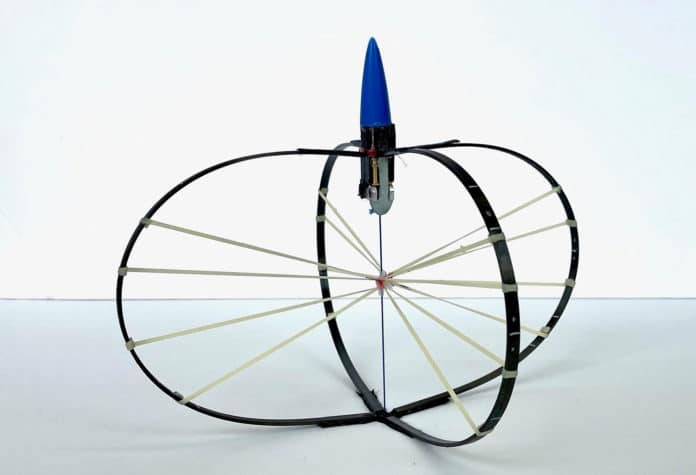For decades, engineers have designed jumping machines that often mimicked or took inspiration from biological jumpers. But, as diverse as the natural world is, evolution hasn’t cracked every option.
Now, UC Santa Barbara engineering professor Elliot Hawkes and collaborators have developed a mechanical jumper that they say can achieve the tallest height of any jumper to date, engineered or biological. The feat allows the robot to leap over challenging terrains on the moon and explore its surface more quickly than the wheeled robot, the researchers say.
Many engineered jumpers have focused on duplicating the designs provided by evolution, and to great effect. But the elements that create a jump in a biological system can be limiting for engineered systems, said Charles Xaio, a Ph.D. candidate in Hawkes’ lab.
“Biological systems can only jump with as much energy as they can produce in a single stroke of their muscle,” Xaio said. Thus, the system is limited in the amount of energy it can give to pushing the body off the ground, and the jumper can jump only so high. But robots can multiply the amount of energy using motors that ratchet or rotate to take many strokes, giving them a huge potential advantage.
“This difference between energy production in biological versus engineered jumpers means that the two should have very different designs to maximize jump height,” said Charles Xaio, a Ph.D. candidate in Hawkes’ lab. “Animals should have a small spring – only enough to store the relatively small amount of energy produced by their single muscle stroke – and a large muscle mass. In contrast, engineered jumpers should have as large a spring as possible and a tiny motor.”
The new jumping robot is quite unlike biological jumpers – the size of its spring relative to its motor is nearly 100 times greater than that found in animals. Researchers devised a new spring, seeking to maximize its energy storage per unit mass. In their hybrid tension-compression spring, carbon-fiber compression bows are squashed while rubber bands are stretched by pulling a line wrapped around a motor-driven spindle.
The mechanical jumper is also designed to be lightweight, with a minimalistic latching mechanism to release the energy for the jump, and aerodynamic, with the legs folding in to minimize air drag during flight. The design features allow it to speed up from 0 to 60 mph (96.6km/h) in 9 meters per second, achieving an acceleration force of 315 G. Researchers say the device can reach the roughly 100-foot height, which they estimate to be close to the feasible limit of jump height with currently available materials.
As they conclude, the design and the ability to exceed the limits set by biological designs set the stage for the reimagining of jumping as an efficient form of machine locomotion. They could therefore represent a practical alternative to flying objects because now they are able to overcome obstacles and reach heights that were previously reserved for only flying robots. This allows them to gather visual data of the terrain from a bird’s eye view when jumping.
In addition, jumping robots can travel across the moon or planets efficiently, without dealing with obstacles on the surface, while also accessing features and perspectives that terrain-based robots can’t reach. Due to the lower gravity, the current model should be able to clear 125 meters in height while jumping half of a kilometer forward on the moon, the team calculated.
